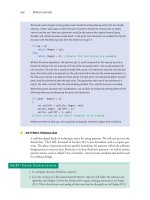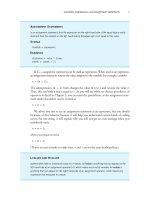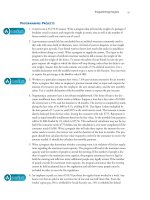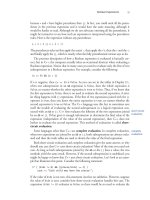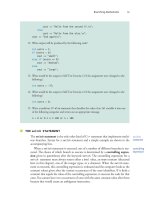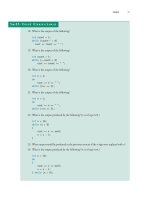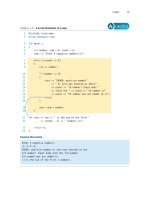Absolute C++ (4th Edition) part 38 potx
Bạn đang xem bản rút gọn của tài liệu. Xem và tải ngay bản đầy đủ của tài liệu tại đây (230.69 KB, 10 trang )
The Standard Class string 375
Self-Test Exercises
Another way to get the computer to treat the value returned by toupper or tolower as a value
of type
char is to use a type cast, as follows:
cout << static_cast<char>(toupper(’a’));
19. Consider the following code (and assume that it is embedded in a complete and correct
program and then run):
cout << "Enter a line of input:\n";
char next;
do
{
cin.get(next);
cout << next;
} while ( (! isdigit(next)) && (next != ’\n’) );
cout << "<END OF OUTPUT";
If the dialogue begins as follows, what will be the next line of output?
Enter a line of input:
I’ll see you at 10:30 AM.
20. Write some C++ code that will read a line of text and echo the line with all uppercase let-
ters deleted.
21. Rewrite the definition of the
newLine function in Display 9.2 but this time use the ignore
member function.
The Standard Class
string
I try to catch every sentence, every word you and I say, and
quickly lock all these sentences and words away in my literary
storehouse because they might come in handy.
Anton Chekhov, The Seagull
Section 9.1 introduced C-strings. These C-strings are simply arrays of characters termi-
nated with the null character,
’\0’. To manipulate these C-strings you need to worry
about all the details of handling arrays. For example, when you want to add characters
to a C-string and there is not enough room in the array, you must create another array
9.3
09_CH09.fm Page 375 Wednesday, August 13, 2003 1:04 PM
376 Strings
to hold this longer string of characters. In short, C-strings require that you the pro-
grammer keep track of all the low-level details of how the C-strings are stored in mem-
ory. This is a lot of extra work and a source of programmer errors. The ANSI/ISO
standard for C++ specified that C++ must now also have a class
string that allows the
programmer to treat strings as a basic data type without needing to worry about imple-
mentation details. This section introduces you to this
string type.
■
INTRODUCTION TO THE STANDARD CLASS
string
The class string is defined in the library whose name is also <string>, and the defini-
tions are placed in the
std namespace. To use the class string, therefore, your code
must contain the following (or something more or less equivalent):
#include <string>
using namespace std;
The class string allows you to treat string values and string expressions very much
like values of a simple type. You can use the
= operator to assign a value to a string
variable, and you can use the + sign to concatenate two strings. For example, suppose
s1, s2, and s3 are objects of type string and both s1 and s2 have string values. Then
s3 can be set equal to the concatenation of the string value in s1 followed by the
string value in s2 as follows:
s3 = s1 + s2;
There is no danger of s3 being too small for its new string value. If the sum of the
lengths of
s1 and s2 exceeds the capacity of s3, then more space is automatically allo-
cated for
s3.
As we noted earlier in this chapter, quoted strings are really C-strings and so they are
not literally of type
string. However, C++ provides automatic type casting of quoted
strings to values of type
string. Thus, you can use quoted strings as if they were literal
values of type
string, and we (and most others) will often refer to quoted strings as if
they were values of type
string. For example,
s3 = "Hello Mom!";
sets the value of the string variable s3 to a string object with the same characters as in
the C-string
"Hello Mom!".
The class
string has a default constructor that initializes a string object to the
empty string. The class
string also has a second constructor that takes one argument
that is a standard C-string and so can be a quoted string. This second constructor ini-
tializes the
string object to a value that represents the same string as its C-string argu-
ment. For example,
string phrase;
string noun("ants");
+ does
concatenation
constructors
09_CH09.fm Page 376 Wednesday, August 13, 2003 1:04 PM
The Standard Class string 377
The first line declares the string variable phrase and initializes it to the empty string.
The second line declares
noun to be of type string and initializes it to a string value
equivalent to the C-string
"ants". Most programmers when talking loosely would say
that “
noun is initialized to "ants",” but there really is a type conversion here. The
quoted string
"ants" is a C-string, not a value of type string. The variable noun
receives a string value that has the same characters as "ants" in the same order as
"ants’, but the string value is not terminated with the null character ’\0’. In theory,
at least, you do not need to know or care whether the
string value of noun is even
stored in an array, as opposed to some other data structure.
There is an alternate notation for declaring a
string variable and invoking the
default constructor. The following two lines are exactly equivalent:
string noun("ants");
string noun = "ants";
These basic details about the class string are illustrated in Display 9.4. Note that, as
illustrated there, you can output
string values using the operator <<.
Consider the following line from Display 9.4:
phrase = "I love " + adjective + " " + noun + "!";
Display 9.4 Program Using the Class string
1 //Demonstrates the standard class string.
2 #include <iostream>
3 #include <string>
4 using namespace std;
5 int main( )
6 {
7 string phrase;
8 string adjective("fried"), noun("ants");
9 string wish = "Bon appetite!";
10 phrase = "I love " + adjective + " " + noun + "!";
11 cout << phrase << endl
12 << wish << endl;
13 return 0;
14 }
S
AMPLE
D
IALOGUE
I love fried ants!
Bon appetite!
Initialized to the empty string.
Two equivalent
ways of initializing
a string variable
09_CH09.fm Page 377 Wednesday, August 13, 2003 1:04 PM
378 Strings
C++ must do a lot of work to allow you to concatenate strings in this simple and natu-
ral fashion. The string constant
"I love " is not an object of type string. A string
constant like
"I love " is stored as a C-string (in other words, as a null-terminated
array of characters). When C++ sees
"I love " as an argument to +, it finds the defini-
tion (or overloading) of
+ that applies to a value such as "I love ". There are overload-
ings of the
+ operator that have a C-string on the left and a string on the right, as well
as the reverse of this positioning. There is even a version that has a C-string on both
sides of the + and produces a
string object as the value returned. Of course, there is
also the overloading you expect, with the type
string for both operands.
C++ did not really need to provide all those overloading cases for
+. If these over-
loadings were not provided, C++ would look for a constructor that can perform a type
conversion to convert the C-string
"I love " to a value for which + did apply. In this
case, the constructor with the one
C-string parameter would perform just such a con-
version. However, the extra overloadings are presumably more efficient.
The class
string is often thought of as a modern replacement for C-strings. How-
ever, in C++ you cannot easily avoid also using C-strings when you program with the
class
string.
T
HE
C
LASS
string
The class string can be used to represent values that are strings of characters. The class string
provides more versatile string representation than the C-strings discussed in Section 9.1.
The class string is defined in the library that is also named <string>, and its definition is
placed in the
std namespace. Programs that use the class string should therefore contain one
of the following (or something more or less equivalent):
#include <string>
using namespace std;
or
#include <string>
using std::string;
The class string has a default constructor that initializes the string object to the empty string,
and a constructor that takes a C-string as arguments and initializes the
string object to a value
that represents the string given as the argument. For example:
string s1, s2("Hello");
converting
C-string
constants to
the type
string
09_CH09.fm Page 378 Wednesday, August 13, 2003 1:04 PM
The Standard Class string 379
■
I/O WITH THE CLASS
string
You can use the insertion operator >> and cout to output string objects just as you do
for data of other types. This is illustrated in Display 9.4. Input with the class
string is
a bit more subtle.
The extraction operator,
>>, and cin work the same for string objects as for other
data, but remember that the extraction operator ignores initial whitespace and stops
reading when it encounters more whitespace. This is as true for strings as it is for other
data. For example, consider the following code:
string s1, s2;
cin >> s1;
cin >> s2;
If the user types in
May the hair on your toes grow long and curly!
then s1 will receive the value "May" with any leading (or trailing) whitespace deleted.
The variable
s2 receives the string "the". Using the extraction operator, >>, and cin, you
can only read in words; you cannot read in a line or other string that contains a blank.
Sometimes this is exactly what you want, but sometimes it is not at all what you want.
If you want your program to read an entire line of input into a variable of type
string, you can use the function getline. The syntax for using getline with string
objects is a bit different from what we described for C-strings in Section 9.1. You do
not use
cin.getline; instead, you make cin the first argument to getline.
1
(So, this
version of
getline is not a member function.)
string line;
cout << "Enter a line of input:\n";
getline(cin, line);
cout << line << "END OF OUTPUT\n";
When embedded in a complete program, this code produces a dialogue like the following:
Enter some input:
Do be do to you!
Do be do to you!END OF OUTPUT
If there were leading or trailing blanks on the line, they too would be part of the string
value read by getline. This version of getline is in the library <string>. (As we will
1
This is a bit ironic, since the class string was designed using more modern object-oriented
techniques, and the notation it uses for
getline is the old fashioned, less object-oriented notation.
This is an accident of history. This
getline function was defined after the iostream library was
already in use, so the designers had little choice but to make this
getline a stand alone function.
getline
09_CH09.fm Page 379 Wednesday, August 13, 2003 1:04 PM
380 Strings
see in Chapter 12, you can use a stream object connected to a text file in place of cin to
do input from a file using
getline.)
You cannot use
cin and >> to read in a blank character. If you want to read one char-
acter at a time, you can use
cin.get, which we discussed in Section 9.2. The function
cin.get reads values of type char, not of type string, but it can be helpful when han-
dling
string input. Display 9.5 contains a program that illustrates both getline and
cin.get used for string input. The significance of the function newline is explained
in the pitfall entitled “Mixing
cin >> variable; and getline.”
Display 9.5 Program Using the Class string
(part 1 of 2)
1 //Demonstrates getline and cin.get.
2 #include <iostream>
3 #include <string>
4 using namespace std;
5 void newLine( );
6 int main( )
7 {
8 string firstName, lastName, recordName;
9 string motto = "Your records are our records.";
10 cout << "Enter your first and last name:\n";
11 cin >> firstName >> lastName;
12 newLine( );
13 recordName = lastName + ", " + firstName;
14 cout << "Your name in our records is: ";
15 cout << recordName << endl;
16 cout << "Our motto is\n"
17 << motto << endl;
18 cout << "Please suggest a better (one line) motto:\n";
19 getline(cin, motto);
20 cout << "Our new motto will be:\n";
21 cout << motto << endl;
22 return 0;
23 }
24 //Uses iostream:
25 void newLine( )
26 {
09_CH09.fm Page 380 Wednesday, August 13, 2003 1:04 PM
The Standard Class string 381
Self-Test Exercises
22. Consider the following code (and assume that it is embedded in a complete and correct
program and then run):
string s1, s2;
cout << "Enter a line of input:\n";
I/O
WITH
string
O
BJECTS
You can use the insertion operator << with cout to output string objects. You can input a
string with the extraction operator >> and cin. When using >> for input, the code reads in a
string delimited with whitespace. You can use the function
getline to input an entire line of text
into a
string object.
E
XAMPLES
string greeting("Hello"), response, nextLine;
cout << greeting;
cin >> response;
getline(cin, nextLine);
Display 9.5 Program Using the Class string
(part 2 of 2)
27 char nextChar;
28 do
29 {
30 cin.get(nextChar);
31 } while (nextChar != ’\n’);
32 }
S
AMPLE
D
IALOGUE
Enter your first and last names:
B’Elanna Torres
Your name in our records is: Torres, B’Elanna
Our motto is
Your records are our records.
Please suggest a better (one-line) motto:
Our records go where no records dared to go before.
Our new motto will be:
Our records go where no records dared to go before.
09_CH09.fm Page 381 Wednesday, August 13, 2003 1:04 PM
382 Strings
Tip
cin >> s1 >> s2;
cout << s1 << "*" << s2 << "<END OF OUTPUT";
If the dialogue begins as follows, what will be the next line of output?
Enter a line of input:
A string is a joy forever!
23. Consider the following code (and assume that it is embedded in a complete and correct
program and then run):
string s;
cout << "Enter a line of input:\n";
getline(cin, s);
cout << s << "<END OF OUTPUT";
If the dialogue begins as follows, what will be the next line of output?
Enter a line of input:
A string is a joy forever!
M
ORE
V
ERSIONS
OF
getline
So far, we have described the following way of using getline:
string line;
cout << "Enter a line of input:\n";
getline(cin, line);
This version stops reading when it encounters the end-of-line marker, ’\n’. There is a version
that allows you to specify a different character to use as a stopping signal. For example, the fol-
lowing will stop when the first question mark is encountered:
string line;
cout << "Enter some input:\n";
getline(cin, line, ’?’);
It makes sense to use getline as if it were a void function, but it actually returns a reference to
its first argument, which is
cin in the above code. Thus, the following will read in a line of text
into
s1 and a string of nonwhitespace characters into s2:
string s1, s2;
getline(cin, s1) >> s2;
09_CH09.fm Page 382 Wednesday, August 13, 2003 1:04 PM
The Standard Class string 383
Pitfall
The invocation getline(cin, s1) returns a reference to cin, so that after the invocation of
getline, the next thing to happen is equivalent to
cin >> s2;
This kind of use of getline seems to have been designed for use in a C++ quiz show rather than to
meet any actual programming need, but it can come in handy sometimes.
M
IXING
cin >> variable;
AND
getline
Take care in mixing input using cin >> variable; with input using getline. For example, con-
sider the following code:
int n;
string line;
cin >> n;
getline(cin, line);
When this code reads the following input, you might expect the value of n to be set to 42 and the
value of
line to be set to a string value representing "Hello hitchhiker.":
42
Hello hitchhiker.
However, while n is indeed set to the value of 42, line is set equal to the empty string. What
happened?
Using cin >> n skips leading whitespace on the input but leaves the rest of the line, in this case
just
’\n’, for the next input. A statement like
cin >> n;
always leaves something on the line for a following getline to read (even if it is just the ’\n’).
In this case, the
getline sees the ’\n’ and stops reading, so getline reads an empty string. If
you find your program appearing to mysteriously ignore input data, see if you have mixed these
two kinds of input. You may need to use either the
newLine function from Display 9.5 or the
function
ignore from the library iostream. For example,
cin.ignore(1000, ’\n’);
With these arguments, a call to the ignore member function will read and discard the entire rest
of the line up to and including the
’\n’ (or until it discards 1000 characters if it does not find the
end of the line after 1000 characters).
09_CH09.fm Page 383 Wednesday, August 13, 2003 1:04 PM
384 Strings
Other baffling problems can appear with programs that use cin with both >> and getline.
Moreover, these problems can come and go as you move from one C++ compiler to another. When
all else fails, or if you want to be certain of portability, you can resort to character-by-character
input using
cin.get.
These problems can occur with any of the versions of
getline that we discuss in this chapter.
■
STRING PROCESSING WITH THE CLASS
string
The class string allows you to perform the same operations that you can perform with
the C-strings we discussed in Section 9.1 and more. (A lot more! There are well over
100 members and other functions associated with the standard string class.)
You can access the characters in a
string object in the same way that you access
array elements, so
string objects have the advantages of arrays of characters plus a
number of advantages that arrays do not have, such as automatically increasing their
capacity.
If
lastName is the name of a string object, then lastName[i] gives access to the ith
character in the string represented by
lastName. This use of array square brackets is
illustrated in Display 9.6.
Display 9.6 also illustrates the member function
length. Every string object has a
member function named
length that takes no arguments and returns the length of the
string represented by the
string object. Thus, a string object not only can be used like
getline
FOR
O
BJECTS
OF
THE
C
LASS
string
The getline function for string objects has two versions:
istream& getline(istream& ins, string& strVar,
char delimiter);
and
istream& getline(istream& ins, string& strVar);
The first version of this function reads characters from the istream object given as the first argu-
ment (always
cin in this chapter), inserting the characters into the string variable strVar
until an instance of the
delimiter character is encountered. The delimiter character is
removed from the input and discarded. The second version uses
’\n’ for the default value of
delimiter; otherwise, it works the same.
These
getline functions return their first argument (always cin in this chapter), but they are
usually used as if they were
void functions.
length
09_CH09.fm Page 384 Wednesday, August 13, 2003 1:04 PM
